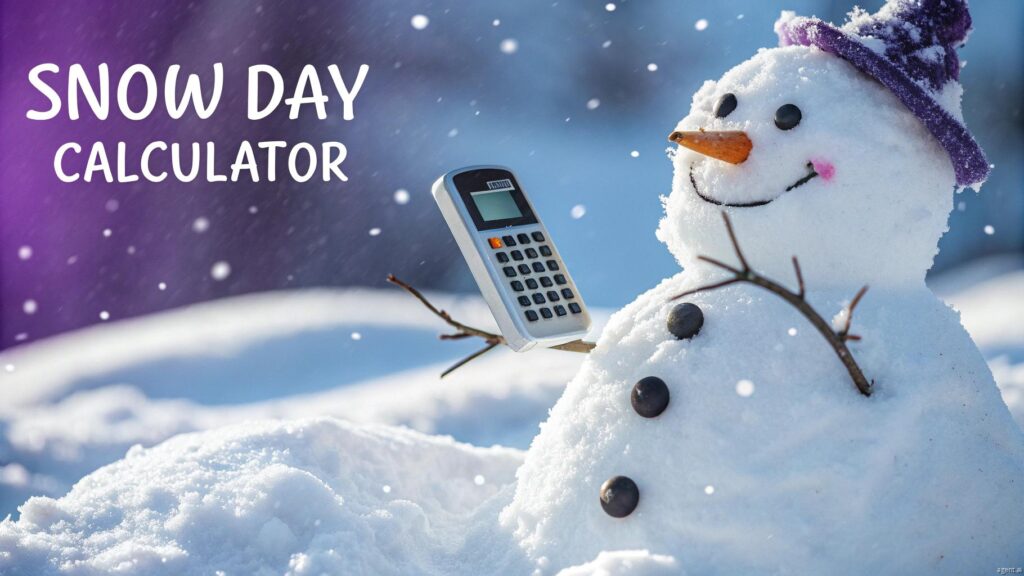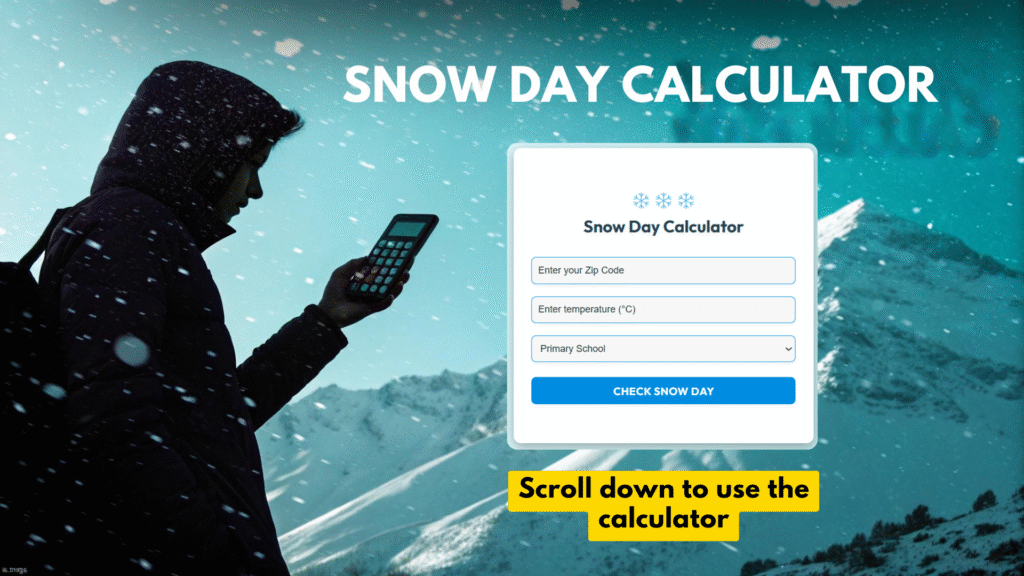❄️ ❄️ ❄️
Snow Day Calculator
Ever wondered if your school will close due to snow tomorrow? The snow day calculator takes the guesswork out of predicting school closings by analyzing real-time weather data and forecasts.
We’ve all been there – staying up late, refreshing the news, hoping for that magical announcement. However, with a reliable snow day predictor, you can now make informed predictions based on actual data. Our snow day calculator for college and K-12 schools uses multiple factors including snowfall amounts, temperature conditions, and road safety to determine closure likelihood. Additionally, the calculator considers each school district’s unique policies, as some close with just a few inches of snow while others require significant accumulation.
How accurate is snow day calculator? Although sudden weather changes can affect predictions, it remains one of the most reliable tools available. By simply entering your ZIP code, indicating snow days already taken, and selecting your school type, you’ll receive a percentage chance or qualitative assessment of a potential snow day. In fact, the school snow day calculator provides tailored results showing whether your chances are high, moderate, or low.
In this article, we’ll walk you through exactly how this tool works and how you can use it to predict school closings like a pro.
What is a Snow Day Calculator?
A snow day calculator is a tool on the internet that guesses the chances of schools closing by looking at weather reports and forecasts. Instead of relying on hunches or old memories of snowy days, these calculators use data and patterns to figure out possible school disruptions ahead of time.
The calculator works by collecting up-to-date details like snowfall amounts, temperatures, and wind speeds from reliable sources such as the National Weather Service. It mixes this information with rules from local school districts, like how much snow it takes to cancel school, and past closure patterns. The end result is a percentage, refreshed or sometimes showing how likely it is your school will be closed.
This tool helps students avoid early-morning stress. It allows parents to plan work hours or find childcare more . Teachers get time to tweak lesson plans or set up remote learning resources. put, snow day calculators act like a forecasting guide making winter’s uncertainties easier to handle for everyone.
A snow day calculator is an online prediction tool designed to estimate the probability of school closures during winter weather events. Created in 2007 as a middle school project by David Sukhin, this digital tool has evolved into a sophisticated system trusted by millions of users across the United States.
The calculator initially started as a simple project but expanded in 2010 when it began automatically retrieving data from the National Weather Service, enabling predictions for any US zip code. Essentially, it functions as a probability engine that analyzes multiple weather variables to determine if conditions warrant school closures.
How does it predict school closings?
The snow day calculator processes several critical factors to generate its predictions:
- Timing and strength of snowstorms
- Observations on the wind
- Temperature readings
- Ice forecasts
- Historical closure patterns for specific regions and schools
What makes this tool particularly effective is its ability to consider storm timing—morning snow typically increases closure chances—along with the expected snowfall amount. Furthermore, the calculator examines how much snow typically shuts down schools in your specific area, recognizing that regional responses vary dramatically. For instance, schools in Texas might close with minimal snowfall, whereas Minnesota schools might require blizzard conditions.
Notably, the calculator becomes more accurate over time. As users report actual outcomes, the system “learns” more about each school and region, continuously improving its prediction accuracy.
Types of schools it supports
The snow day calculator accommodates various educational institutions, making it versatile for different users. When using the calculator, you’ll typically select from these school categories:
- Public Urban schools
- Public Rural schools
- Private/Preparatory schools
- Boarding schools
This categorization is important since different types of schools often have varying closure thresholds. Rural schools, for example, may close more readily than urban institutions due to transportation challenges on country roads.
Unlike some weather tools that might only predict general conditions, the snow day calculator specifically focuses on school closure probabilities, providing predictions based on your ZIP code and local weather patterns. Though primarily designed for K-12 institutions, many college students also rely on similar prediction methods to anticipate campus closures.
How the Snow Day Calculator Works

Behind every snow day prediction lies a sophisticated algorithm analyzing multiple data points simultaneously. The original snow day calculator started as a middle school project in 2007, later expanding in 2010 to automatically retrieve National Weather Service data for any US ZIP code.
Snowfall and weather data
In the snow day calculator, the quantity and timing of precipitation are analyzed in order to determine the likelihood of snow days. Morning snowfall significantly increases closure chances compared to afternoon or evening precipitation. The system processes snowfall probability forecasts for specific accumulation thresholds, ranging from ≥1 inch to ≥18 inches.
Furthermore, the calculator considers storm strength, not just total accumulation but intensity over time. This comprehensive analysis allows for predictions up to 14 days in advance, with some systems updating every 30 minutes as weather forecasts change.
Temperature and road conditions
Temperature plays a crucial role in predictions, with the calculator examining both actual recorded temperatures and “feels like” readings that incorporate wind chill and humidity factors. Sometimes, extreme cold alone can trigger school closures, even without significant snowfall.
Road conditions often become the deciding factor in school closure decisions. The calculator analyzes ice forecasts with particular attention, as even minimal snow followed by freezing rain creates especially hazardous driving conditions. Consequently, freezing rain probability forecasts (from ≥0.01 inch to ≥0.50 inch) factor heavily into calculations.
School district policies
Each school district maintains unique closure thresholds—the calculator accounts for these differences across geographical regions. As David Sukhin, the calculator’s creator, noted, Boston schools fall midway on the winter-toughness scale, closing more readily than Michigan or northern New England schools but less easily than Washington D.C. or Texas institutions.
Historical snow day trends
Perhaps most impressively, the calculator incorporates machine learning elements. As users report what actually happened in their districts, the system continuously improves its prediction accuracy. This historical data analysis helps identify regional patterns and closure tendencies over time.
Additionally, some calculators even factor in storm “hype”—the social media and TV buzz surrounding a weather event—which can swing prediction probabilities by 10-15%.
Ice and Freezing Rain
Freezing rain is the boss of all winter precipitation for its slipperiness. A thin glaze of ice on roads can be more disruptive than two inches of snow. Calculators weigh ice accumulation heavily because it often triggers closures even when total precipitation is low.
How to Use our Snow Day Calculator
Using a snow day calculator is simple yet effective. With over 5 million users annually representing more than 100 million hits, these user-friendly tools have become the go-to resource for predicting school closures. Let’s explore the straightforward process of getting your prediction.
Step 1: Enter your ZIP code
Begin by entering your location information in the designated field. The calculator accepts both US ZIP codes and Canadian postal codes. This geographical information is crucial as it allows the system to access hyper-local weather data specific to your area. Once you input your ZIP code, the calculator connects with National Weather Service data to retrieve accurate, location-specific forecasts.
Step 2: Add today’s temperature
Now, input the current temperature in your area. Temperature plays a key role in school closure decisions, especially when extreme cold risks student safety. Many districts have guidelines, like canceling school if wind chills drop below a certain threshold (e.g., -2°C to -5°C). Tracking today’s temperature helps evaluate whether conditions are too harsh for travel or outdoor exposure.
Step 3: Choose your school type
Select your specific school category from the dropdown menu. Options typically include:
- Public Urban
- Public Rural
- Private/Preparatory
- Boarding
This selection is vital because different types of educational institutions have varying thresholds for closures. Rural schools, for instance, might close more readily than urban ones due to transportation challenges on country roads.
Step 4: Click calculate and view results
After entering all required information, click the “Check Snow Day” button. The calculator processes your inputs alongside current weather forecasts and historical data to generate a prediction. Results typically appear as a percentage chance or qualitative assessment (such as “High Chance,” “Moderate Chance,” or “Low Chance”) of a snow day.
Many users check their predictions multiple times throughout the day—sometimes even several times hourly—as forecasts update with new weather information. For those seeking additional convenience, some calculators offer text message notifications about snow day probabilities.
Understanding and Trusting the Results

When examining your snow day calculator results, understanding the numbers is crucial for making informed decisions. The prediction percentage represents the likelihood of a school closure based on multiple data points analyzed by the algorithm.
How accurate is the snow day calculator?
Snow day calculators boast impressive accuracy rates, with some claiming to be “wickedly accurate” and even “100% accurate in many locations”. Nevertheless, real-world testing reveals more nuanced results. It’s usually a good bet that a snow day is likely when a calculator predicts a chance of closure of 80% or higher. For instance, in Boston, one test found the calculator correctly predicted closures 8 out of 10 times when it forecasted over 70% odds.
Accuracy generally increases over time as the calculator “learns” from users reporting actual outcomes in their regions. This machine learning component continually improves predictions by incorporating historical closure patterns specific to your area.
What a high or low chance means
A prediction percentage isn’t a weather forecast but rather a probability estimate of school closure. According to meteorologists, these probabilities can be calculated using a formula where probability equals forecaster confidence multiplied by the affected area percentage.
Generally, prediction ranges follow this pattern:
- 80-100%: Widespread chance, likely affecting most schools in the area
- 60-70%: Numerous closures expected
- 40-50%: Scattered closures, with some schools remaining open
- 10-30%: A rare occurrence that affects a small number of institutions only
Limitations of prediction tools
Even the most sophisticated calculator faces inherent limitations. First, weather systems exhibit chaotic behavior where small changes in initial conditions can lead to drastically different outcomes. Second, microclimates (localized areas with unique weather patterns) may experience different conditions than broader regional forecasts suggest.
Moreover, school closure decisions involve human judgment factors that algorithms cannot fully capture. Unexpected events like power outages or staffing shortages might trigger closures regardless of weather conditions.
Overall, the snow day calculator serves as a valuable planning tool but works best as one component of your winter weather preparation strategy.
Conclusion
Snow day calculators have undoubtedly transformed how students and parents prepare for winter weather events. Throughout this article, we’ve explored how these prediction tools evolved from a middle school project into sophisticated systems trusted by millions across North America.
First and foremost, these calculators analyze multiple factors simultaneously – from snowfall amounts and timing to temperature readings and road conditions. They also consider each school district’s unique closure policies, recognizing that what closes schools in Minnesota differs dramatically from what closes schools in Texas.
Although no prediction tool boasts perfect accuracy, snow day calculators certainly provide reasonable estimates based on comprehensive data analysis. Using the calculator remains straightforward – simply enter your ZIP code, indicate snow days already used, select your school type, and receive an instant prediction. The percentage or qualitative assessment you receive offers valuable insight into whether you should prepare for a regular school day or possibly enjoy an unexpected break.
Despite their sophistication, these calculators face limitations due to the weather’s inherently chaotic nature and the human judgment factors involved in closure decisions. Nevertheless, they remain excellent planning tools that take much of the guesswork out of predicting whether you’ll hear those magical words: “School’s closed tomorrow!”
Snow days don’t have to turn your week upside-down. By integrating a snow day calculator into your winter toolkit, alongside official channels—you’ll make data-driven, safe decisions that keep your family prepared and worry-free.
Further Reading:
- “How Schools Use Data in Emergency Planning” (EdWeek)
- “Winter Weather Safety Tips” (National Weather Service)
- “Optimizing Your Home for Power Outages” (Energy.gov)
Stay ahead of the storm, not behind it—embrace predictive planning with a snow day calculator.
FAQs
1: How does the Snow Day Calculator work?
It gathers weather data (snowfall, temperature, etc.) and combines it with school district policies and historical closure patterns. Algorithms then calculate a probability of school being canceled, often updating this forecast regularly.
2: Is the Snow Day Calculator accurate?
Accuracy varies but many report 80-90% success. Rely on it as a strong indicator, but always confirm with official school announcements for the final decision.
3: Do I need to sign up to use the Snow Day Calculator?
Some may have optional sign-ups for extra features like personalized alerts. Many calculators offer basic predictions without requiring registration.
4: Can I use the Snow Day Calculator outside of the U.S. and Canada?
Most popular calculators primarily focus on the U.S. and Canada due to specific data availability. Accuracy may be limited or non-existent elsewhere.
5: What information do I need to enter to check for a snow day?
Typically, you’ll need to enter your ZIP code or select your school district so the tool can access localized weather data and policies.
6: How often is the Snow Day Calculator updated?
Reputable calculators often update hourly or more frequently to reflect the latest weather forecasts and conditions.
7: Does the Snow Day Calculator consider school policies?
Yes, advanced calculators allow you to select your school district, factoring in their specific closure thresholds (e.g., minimum snow depth).
8: Can the Snow Day Calculator predict early dismissals or delays?
Some advanced tools are starting to incorporate predictions for early dismissals or delays, but this feature isn’t universally available. Official school communication is key.
9: What should I do if the calculator predicts a snow day?
Monitor official school district communication for confirmation. If aligned, plan accordingly for childcare, work, or a day off, while prioritizing safety.


